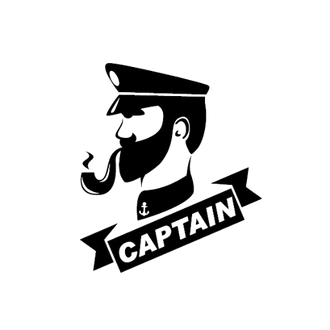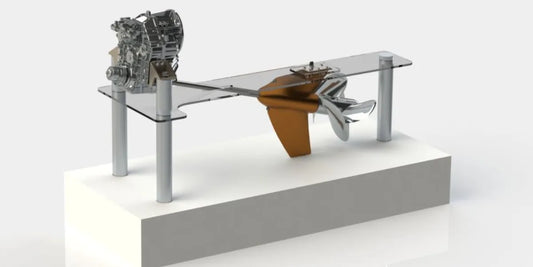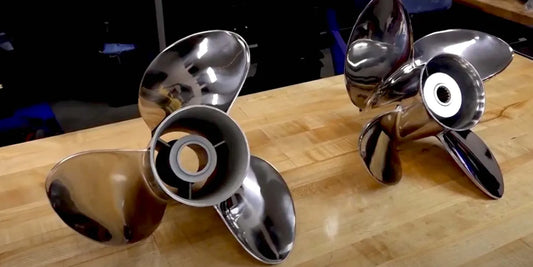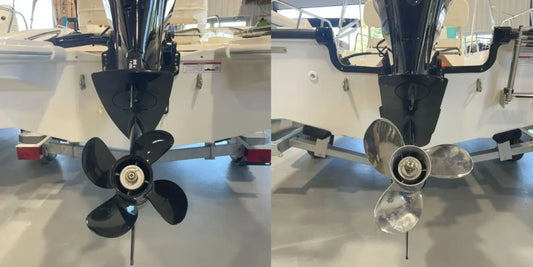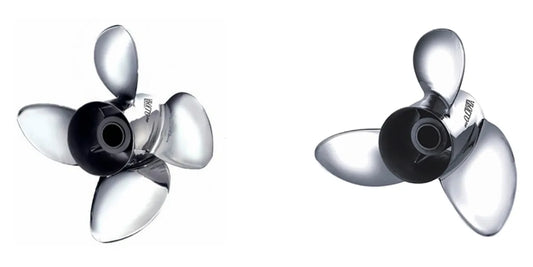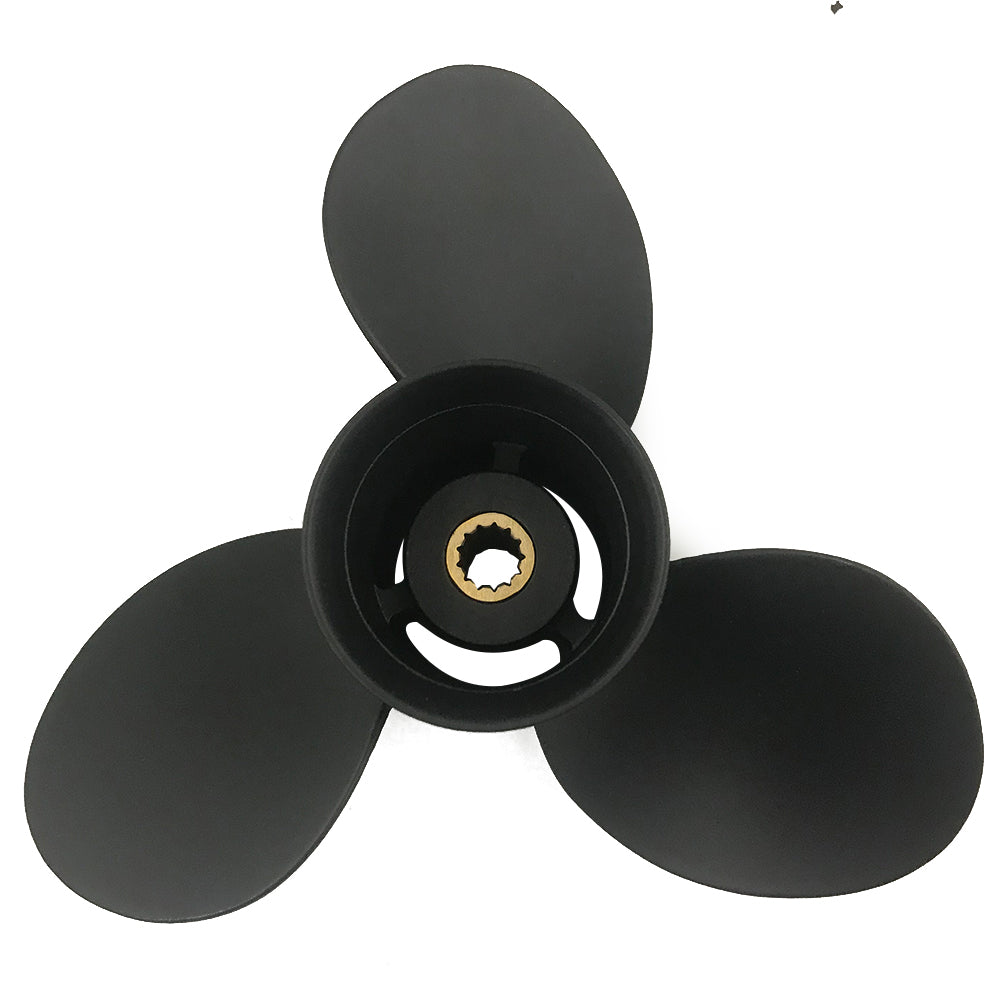The propeller choice is always key in optimizing your boat's performance. Among the available steel options, stainless steel propellers are the best choice for enthusiasts and professionals. They offer superior durability and have advanced design and functionality to ensure performance, which these propellers are sure to maximize. In this article, I will cover the seven flawless stainless steel propeller advantages that will change the investment angle for any user hoping to improve their boating experience. For those who want to achieve more controllable speed, fuel economy, or handling, stainless steel propellers are the next step forward.
Why should I choose a stainless steel propeller over an aluminum one?

Comparing durability: Stainless steel vs. aluminum propellers
Stainless steel propellers genuinely outperform aluminum propellers in durability. Since stainless steel is five times stronger than aluminum, it's much less vulnerable to impact damage and deformation. Unlike the rest, this material has low elasticity, which enables it to sustain stress even under high deformation, such as when hitting debris or working in turbulent waters.
A stainless steel propeller is shaped and performs better when striking debris or working in turbulent waters, but aluminum propellers are relaxed on lighter weight and cost. Prone bending and cracking make them stiffer and overall rough, gaining the equivalent depreciation in performance, which, sadly, results in much maintenance over time. Luckily, these constructions allow for sounder corrosion protection to be endured, more notably in salt water than aluminum. Thus, both ensure endurance and lifespan.
Corrosion Resistance: Stocks and Steel offer the best saltwater protection.
Material Strength: Aluminum becomes soft after high amounts of hot work and is at least 5 times weaker than steel.
Impact Resistance: Aluminum is much more fragile to impact, while stainless steel maintains its hardness much better.
Longevity: Harder materials require less maintenance, extending propeller age.
Thanks to the previous reasons, people have started leaning toward adopting long-term usage of stainless steel for boaters.
Performance differences between stainless steel and aluminum props
Analyzing the technical characteristics of stainless steel and aluminum propellers reveals fundamental differences.
Strength and Durability: Notably, stainless steel achieves a blade design with finer edges as it is 5 times stronger than aluminum, which suffers from bending and breaking under high stress. This further increases the performance and efficiency of aluminum propellers by drag reduction. Aluminum propellers are also strong but can bend and break under peak loads.
Weight: Due to their lower inertia, aluminum propellers are more beneficial to slow and small boots. However, the increased weight of stainless steel propellers allows for better stability and boat maneuvering at peak speeds.
Efficiency: High loads and high RPMs are best handled by stainless steel propellers, which maintain their geometry. On the other hand, aluminum propellers flex under said conditions and are rendered useless as they lose thrust and efficiency.
Cost: Aluminum propellers, while affordable, are handy for recreational sailors with low-power motors. Experienced sailors are better off with durable, expensive stainless steel propellers, as they appreciate the enhanced performance over time.
Choosing the right propeller varies based on your particular boating needs, all the while keeping in mind performance targets, how frequently you would go boating, the monetary budget, and the power of your engine.
Cost-effectiveness in the long run: Stainless steel propeller advantages
Although stainless steel propellers have a hefty price tag, purchasing them immediately has excellent financial rewards. Here is the ultimate value breakdown:
Durability and Longevity: Stainless steel doesn't just corrode easily, so there would be no bending or wear. This lack of corrosion increases aluminum propellers' life, ultimately reducing maintenance costs.
Enhanced Performance: Stainless steel has superior strength, which allows it to be used at high speeds without losing shape. Because they can maintain consistent performance and facilitate smoother sailing, which results in decreased expenditure on fuel.
Minimal Damage to Blades: Sustaining in harsh water conditions, their engineering allows them to stay durable, enhancing their resistance to impact and abrasion. The need to frequently purchase new ones is eliminated due to their prolonged lifespan.
As they help reduce long-term operational costs, their reliability increases, too. The investment rewards buyers with prolonged performance and efficiency while making an overall purchase worthwhile.
What are the key benefits of using a stainless steel prop for my boat?

Improved acceleration and top speed with stainless steel propellers
Because stainless steel is stronger and more rigid than aluminum, its propellers provide better acceleration and top speed. Due to their durable construction, blades can be thinner, improving hydrodynamics. This leads to better water displacement and propeller efficiency. Moreover, higher rotational forces do not negatively affect the shape of stainless steel designs; thus, they can perform well even at high speeds.
Blade Strength and Thickness: Superior tensile strength enables thinner blades, decreasing resistance in water.
RPM Efficiency: Under stress, stainless steel maintains the propeller's shape, allowing for high performance at high revolutions per minute.
Speed Gains: Tests show that, depending on the boat design and engine power, stainless steel props can boost top speed by 5-10% compared to aluminum props.
Hole Shot Acceleration: Stain steel propellers have sharper edges, allowing for greater precision and grip, causing faster takeoffs.
Stainless steel propellers are a technical advancement for boats, and by using them, the boat's overall performance can be improved, making them ideal for speed and acceleration lovers.
Enhanced fuel efficiency and reduced drag
Reduced drag and improved fuel efficiency are significant benefits of using stainless steel propellers. The meticulously crafted and thinner blades reduce water resistance, improving the overall hydrodynamics. As a result, propulsion is smoother, the strain on the engine is lessened, and fuel usage is reduced. To achieve these results, the following details should be taken into consideration:
Blade Thickness: Stainless steel outperforms aluminum. It is far more efficient in creating thinner blades, which reduces drag.
Blade Design: Advanced geometrical designs such as cupping and a rake angle can improve water flow while minimizing turbulence.
Material Strength: Stainless steel's strength facilitates efficient blade shape designs, which would otherwise not be possible with higher loads due to its lack of durability.
These factors prove why stainless steel propellers yield such effective results. They are a cost-efficient option that improves overall performance while drastically cutting fuel expenses.
Better handling and control in various water conditions
Because of the material properties and design of the stainless steel propellers, they provide unparalleled control and handling in a variety of water conditions.
Blade Rigidity: Sharp stainless steel has a high tensile strength, so the blades do not buckle under pressure, allowing for consistent performance in rough waters.
Precision Engineering: Advanced thrust-improved blade geometries, such as variable pitch and optimized rake angles, improve responsiveness and consequently allow finer controllability.
Corrosion Resistance: Stainless steel’s resistance to corrosion increases reliability in saltwater and freshwater regions, providing constant control regardless of extended usage.
The smooth surface finish of stainless steel increases stability and steering in choppy waters due to lowering the risk of cavitation, which cavitates the stainless steel’s surface. This phenomenon is known as reduced cavitation.
Combining these features allows the propellers to meet sophisticated demands, making it suitable for numerous boating locations and conditions.
How does a stainless steel propeller improve my boat's performance?

Increased blade strength and reduced flexing
When it comes to propellers, stainless steel wins hands down. They outperform their aluminum counterparts because of their superior blade strength, which ensures minimal flexing under strain or high loads. This enables the prop to sustain and improve its overall efficiency and effectiveness. The enhanced performance output is particularly evident in acceleration and increasing thrust in harsh conditions like towing or steering through turbulent waters.
Material Tensile Strength: Stainless steel has a tensile strength of approximately 70,000-90,000 psi, significantly greater than aluminum, nearly 30,000 psi.
Operational Consistency: You can rely on stainless steel blades and their output along lower RPM ranges while fighting choppy waters.
Durability: Improved resistance to bending out of shape will ensure prolonged performance in more aggressive applications.
These advantages make stainless steel propellers the go-to for boaters after reliable and improved handling in varying conditions.
Superior pitch retention for consistent performance
Due to their rigidity and structural integrity, stainless steel propellers are unrivaled in pitch retention. Propellers made of aluminum are more flexible under heavy loads, whereas stainless steel propellers can better take on stresses without losing their blade geometry. Because of this, thrust and efficiency can be obtained at different RPMs and even under harsh weather conditions, like high-speed cruising or heavy currents.
Strength/Stiffness (Rigidity): Stainless steel has approximately five times the tensile strength of aluminum, so it's less likely to change shape under stress.
Accuracy: The manufacturing method of stainless steel results in much tighter tolerances, guaranteeing optimal blade geometry and pitch.
Reliability At High RPM: The propeller's material helps maintain strength, guaranteeing stability and consistent output at higher rotational speeds.
With all these characteristics, stainless steel propellers are ideal for boaters looking for performance under harsh conditions.
Improved thrust and power transfer to the water
Steel and stainless steel propellers manufactured thrust and power transfer due to their flex resistance with high load and accurate design. Withstood flexing, ensure the blade angle stays consistent with the operation, improving hydrodynamic efficiency. Fuel energy losses are lower because of the reduced power loss during hydrodynamic energy transmission from the engine to the water.
Material Strength: The tensile strength of stainless steel is approximately 485 Mpa, allowing higher withstanding of deformation than aluminum lacks.
Blade Geometry: Tight tolerances assured by blade machining combined with pedestal-increased blade shapes that enhance propulsion efficiency.
Durability: Stainless steel's greater density improves power exertion in rough waters or at higher RPMs, boosting performance under high stress.
Combining these factors justifies the increase in thrust and power transfer, making stainless steel propellers appropriate for high-performance boating applications.
Are stainless steel propellers suitable for all types of boats and engines?

Matching stainless steel props to different boat types and sizes
The selection process for a boat’s matching stainless steel propellers depends on the vessel's features and its prospective purpose. Using stainless steel propellers on smaller ships or those with lower horsepower engines is less favorable due to weight constraints and associated costs. Nonetheless, using stainless steel props benefits mid-sized to larger water vessels, particularly those harnessed in water sports or heavy-duty engagements.
Boat Size and Weight: Stain steel props' added thrust and strength benefit bigger or heavier vessels, especially when used at speed and under notable load.
Engine Power: With mighty (‘over 100 HP’) engines, the attached steel props become instrumental because they can withstand immense torque without distortion.
Intended Use: When considering operation in rough waters, towing, or other types of activity, stainless steel props are a favorable option because of their superior reliability compared to aluminum props.
Propeller Pitch and Diameter: Stainless steel props deliver tighter pitch and diameter tolerances, ensuring smoother operation and enhanced performance in advanced or demanding propulsion setups.
Selecting the correct stainless steel propeller involves performance requirements and technical fitment. If your setup corresponds to these factors, the gain from enhanced thrust, efficiency, and strength will supersede the cost.
Compatibility with various outboard and inboard engines
If I get the specs right, stainless steel propellers can be used for almost any outboard or engine. Here are the things I make sure to look for when selecting a propeller and its specs:
Matching the Engine Shaft Size: The propeller hub must match the engine shaft diameter and spline count for proper mechanical function.
Checking Gear Ratio Compatibility: The engine’s gear ratio must also be considered. It determines the relative effect of the propeller pitch on speed and acceleration, which is very important.
Checking RPM Range: A correctly selected propeller makes achieving a target speed easier. The engine can be used within its recommended RPM range at wide-open throttle without straining or working inefficiently.
Checking Horse Power and Torque: A propeller will fail if its designed horsepower and torque exceed the engine's output.
Cavitation and Ventilation: When under heavy loads or while moving at high speed, a matched stainless steel prop minimizes cavitation, thus enhancing proper ventilation and ensuring smoother operation.
Considering all these factors, I can ensure that the stainless steel propeller fits well while providing additional benefits related to the engine's capabilities in terms of performance, overall thrust, efficiency, and durability.
Considerations for choosing the right stainless steel propeller
In choosing which stainless steel propeller to use, several considerations are critical in determining its performance and durability for my engine and application:
Engine RPM Range: I evaluate the required RPM for my engine at WOT (Wide open throttle) in assessing propeller pitch. A higher-pitched propeller reduces RPM, while a lower pitch increases it. Matching the prop with my engine's ideal RPM range enhances efficiency and prevents strain.
Horsepower and Torque Output: In overloading or under-performing, fulfilling the engine's horsepower, I choose a propeller that fulfills the engine's required horsepower and torque. This selection ensures practical durability and consistent operation even when subjected to heavy loads or harsh weather conditions.
Speed and Acceleration Requirements: If I want to improve my top-end speed, I may use a higher-pitch propeller, which lowers drag while enabling the engine to reach greater velocities. If I prefer better acceleration when towing, I like a lower-pitch prop for quicker responsiveness.
Avoiding Cavitation and Ventilation: A matched stainless steel propeller can prevent damage to the prop or thrust reduction caused by cavitation. I examine the blade shape and ensure that the cooling air does not interfere with the propeller's operation, especially when it is running at high speeds or shallow depths.
Application and Load: Choice is mainly dependent on the heavy utilization. If the use involves heavy loads or rough water, I may consider a propeller with an increased blade count or a lower pitch angle to maintain thrust. A more streamlined design and higher pitch angles are suitable for high-speed applications.
Cavitation, ventilation avoidance, and load application greatly influence these technical parameters. This ensures alignment with my specific requirements so that the selection and justification of the stainless steel propeller can be made for optimal performance and durability.
What are the design advantages of stainless steel propellers?

Thinner blade profiles for enhanced efficiency
The new stainless steel propeller has thinner blades that have dramatically improved efficiency. The thinner profile minimizes drag and turbulent resistance when passing through the liquid, allowing smoother and faster movement in different conditions. This design further improves fuel consumption, as the engine works less to maintain speed, an advantage for long-distance travel or frequent usage.
Technically, a thinner blade affects multiple factors. Firstly, they can complement higher setting pitch or top-end speed throttle, which is best suited for reduced weight or high-speed scenarios. Secondly, with proper ventilation, there is less cavitation due to better waterflow across the blade surface. Such benefits prove that a thinner blade profile is the best option for maximum speed, efficiency, and engine performance.
Customizable pitch and diameter options
It is true that features that allow the customization of pitch and diameter significantly affect the performance of a propeller. Customization should be done thoughtfully. I believe these features deeply impact the propeller's performance and should be customized precisely. Adjusting the pitch means speed or power can be optimized; for instance, a higher pitch increases top-end speed, while a lower pitch would be better for acceleration and load-carrying capacity. Similarly, customizing the diameter affects torque and thrust-handling capability. A larger diameter increases thrust for heavier loads, while a smaller one favors lighter applications requiring high speeds.
These changes are self-explanatory within the context of the technology. Changing the pitch affects other variables, such as engine RPM and the quantity of fuel burnt—the higher the pitch, the lower the RPM, and therefore, the more efficient the system gets. Pushing the throttle harder increases RPM, so better torque can be achieved at lower speeds. Throttle adjustment can be done within certain constraints while modifying the diameter. Increasing the radius decreases blade area and water displaced, hence cavitation risk, thrust delivery, and hydrodynamic nature of the system are affected. When optimal engine and propeller performance is desired, the right combinations of speed, efficiency, and other operational necessities need to be carefully calibrated along with the pitch and diameter.
Advanced cupping and rake designs for optimal performance
With advanced capabilities of cradle and rake, they work together to optimize propeller operation on given applications. “cupping” denotes the slight curve or lip over the trailing edge portion of the propeller blades. This added design feature enhances the blade's grip on the water, reducing slip and fuel spending and allowing the engine to operate at higher speeds or heavier loads with minimum revs. In addition, cupped blades can affect other parameters such as RPM, propulsion in aerated water, and reduced cavitation.
“Tilt, away from the hub” is a Rake Angle. High bow angles increase rake height, which increases bow lift and is suitable for high-speed use, giving controlled behavior and performance on rough waters. On the other hand, low bow angles increase stability and thrust to bear heavy weights. Both cupping and rake adjustments will directly influence the propeller's specific thrust value, hydrodynamics, and engine load capacity, which is, of course, designed for a particular purpose. The goals you want for lowered fuel consumption, better acceleration, or improved handling in difficult working conditions can be realized from propeller performance design by adjusting the combination of these parameters.
Frequently Asked Questions (FAQs)
Q: What are the main advantages of using a stainless steel boat propeller?
A: Compared to aluminum propellers, stainless-steel boat propellers provide longer-lasting performance because they are less susceptible to corrosion and damage. They also offer better fuel economy with higher top-speed performance. Additionally, stainless-steel propellers excel at maintaining shape under high stress, which results in less drag and reliable performance through water.
Q: How does a stainless steel prop compare to an aluminum prop for fishing?
A: Stainless steel props deliver better durability and performance, especially in shallow water, making them superior for fishing. Also, stainless-steel propeller blades are more potent and thinner, allowing for better acceleration and bite. These benefits come in handy when quickly maneuvering to tight fishing spots or when the water demands quick starts to reach fishing locations.
Q: Why is it better to have 3-blade stainless steel propellers instead of 4 or 5-blade propellers?
A: It solely depends on your boating preference. For recreational boating and fishing, 3-blade propellers tend to have the highest top speeds, which give better fuel economy. In contrast, four and 5-propeller blades ensure better acceleration while providing improved stability and smoother operation in rougher terrains. Therefore, it is also essential to consider the size of your boat, engine strength, and the intended use so that the correct number of blades can be picked.
Q: Which brand is better, Yamaha and Mercury, regarding their stainless steel propellers?
A: Both Yamaha and Mercury have reputable names regarding stainless steel propellers. Yamaha propellers are reliable in terms of durability and performance because they cover broad fields practically. Popular with precision engineering, Mercury Marine, which is known for their propellers, including the Flo-Torq hub system, also tends to have a lot of praise due to its compatibility with cooler boating conditions. Most users always have the dilemma over the two that come with their outboard engine and which brand they prefer.
Q: Why do stainless steel props have such a significant marking as x15, x16, x17, x18, x19?
A: Propeller pitch relates to the distance a propeller is expected to move forward for each complete revolution. Higher propellers, like x19, are designed to go faster at the engine's maximum speed but take longer to throttle up. Lower propellers enable better acceleration but lower cruising speed. It is critical to identify the correct pitch based on the engine power, weight of the boat, and performance expectations. Propeller pitch is a crucial factor that must match your boating conditions and engine specifications.
Q: Do boaters find value in propelling the investment from aluminum to stainless steel?
A: While initially higher in price, boaters looking to maximize value will eventually invest, as props made from stainless steel significantly outperform aluminum propellers. They can outlast their competition with better durability and performance under heavy loads, improving fuel economy. Unlike aluminum, these grade 316 propellers remain in shape and are cost-effective when replaced, reducing the need for frequent repair or replacement.
Q: What sets Solas's stainless steel boat propellers apart from others?
A: Sola's stainless steel propellers are respected for their performance and quality in the marine industry. They are efficient, durable, economically priced, and often more manageable on the budget than Yamaha or Mercury. Solas Propellers offer good performance for various uses, including leisure or tougher conditions. Solas is sometimes seen as a dependable and excellent value option for boaters who want to switch to stainless steel.
Q: Can a standard hub system with a stainless steel propeller be used?
A: Most stainless steel propellers are designed to work with standard hub systems. However, verifying whether your propeller and hub system are compatible is still best. Some brands, like Mercury, have propeller stainless steel hubs for their Flo-Torq hub system that work the best with their proprietary hubs. When changing to a stainless steel propeller, always confirm clearances with the engine specs and any marine expert for the best results.
